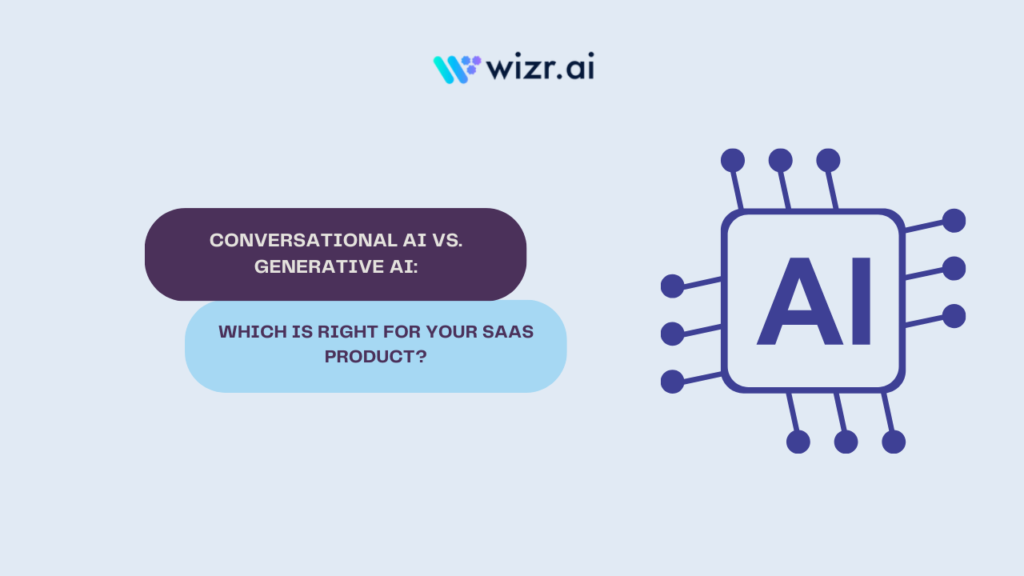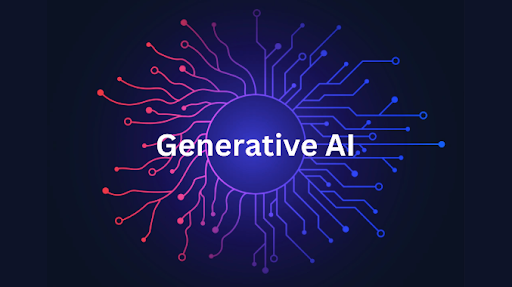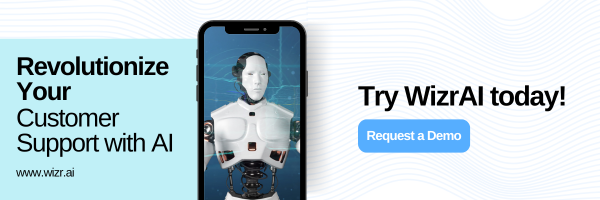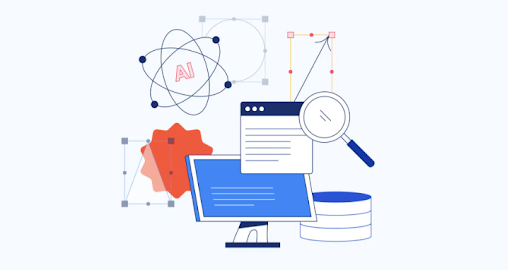In AI-powered SaaS, it is important for businesses to understand the different roles of Conversational AI and Generative AI. While both types of AI play essential roles in enhancing user experiences, they have different functions and are based on distinct technologies.
Conversational AI for SaaS is designed to hold dialogue with users, making it a useful tool for virtual assistance and customer support. On the other hand, Generative AI for SaaS has concerned itself with producing content such as text, images, among others from the learned data sets.

This distinction underscores the significance of selecting an appropriate AI technology that matches specific business needs. It is clear that each has its unique advantages when we compare conversational AI vs. generative AI in SaaS. They simulate conversations like human beings to help improve customer service; support and user engagement through conversational AI platforms that have been developed specifically for businesses.
In contrast, Generative AI encourages creativity and innovation by generating new content that can be used in marketing, product design, and more. To be able to make informed decisions that will enhance success in today’s competitive environment, understanding how generative AI works and how conversational AI works, as well as the benefits of conversational AI in SaaS and benefits of generative AI in SaaS, is crucial.
What is Conversational AI ?

Conversational AI is focused on having machines converse like humans. It blends different technologies like natural language processing (NLP), machine learning, and automated speech recognition to comprehend and respond to user inputs just like humans would communicate. The technology has now become indispensable in enhancing SaaS products with AI capabilities, offering personalized and efficient services. Conversational AI is designed to perform particular tasks where it can actively engage users online by adapting its content depending on different conversational contexts in real-time.
This necessitates its flexibility in situations that require high levels of user engagement and satisfaction, hence making Conversational AI invaluable in a number of sectors like customer care and healthcare.
What is Generative AI ?

Generative AI is a subfield of artificial intelligence focused on generating new, unique content using observed data. While traditional AI systems analyze or predict using inputs, the outputs of Generative AI are entirely new. The technology is driven by deep learning models that can spot patterns and structures in large datasets, using this to craft new pieces of work similar to the data they gained their knowledge from.
For SaaS, Generative AI is affecting how enterprises are able to produce content at scale and even customize user experiences across their offerings. This enables SaaS providers to automate creative processes, which were previously considered only capable of human intuition and creativity. The generative AI benefits include enhanced efficiency and scalability in content creation, making it a valuable asset for AI-powered SaaS solutions.
Conversational AI vs Generative AI: Key Differences Explained
When comparing Conversational AI vs. Generative AI in SaaS, it’s essential to understand their unique roles. While both are forms of AI, they serve different purposes in AI-powered SaaS products.
Conversational AI for SaaS is built to interact with users. It powers AI chatbots and virtual assistants that can understand and respond to user questions. This type of AI is crucial for improving customer service in SaaS. By using a conversational AI platform, businesses can provide instant support and personalized experiences, which boosts user satisfaction.
On the other hand, Generative AI for SaaS focuses on creating novel content. This can consist of different forms, spanning from text to images. In SaaS, generative AI can help with content creation, such as writing marketing copy or designing graphics. The benefits of generative AI in SaaS include saving time and enhancing creativity by producing content automatically based on user needs.
Another important difference is how these AI technologies work. Conversational AI works by understanding and responding to human language in real-time. It’s trained to recognize speech patterns and context, making it ideal for direct communication. In contrast, Generative AI works by analyzing large datasets to produce desired outcomes. It learns from examples and generates content based on patterns it has detected.

Benefits of Conversational AI for SaaS Businesses
Conversational AI offers several advantages for SaaS products, particularly in improving customer interactions. Here are some key benefits of conversational AI in SaaS:
24/7 Customer Support
- With a conversational AI platform, businesses can provide instant, round-the-clock support. This allows users to get help anytime, improving satisfaction and reducing operational costs.
Personalized User Experiences
- Conversational AI for SaaS tailors responses based on individual user behavior and preferences. This leads to:
- More relevant interactions
- Increased customer retention
- Enhanced user loyalty
Conversational AI in SaaS also makes it easier to scale customer support operations. As a SaaS product grows, so does the need for support. AI-powered SaaS solutions can handle this increased demand without requiring additional human resources. This scalability ensures that businesses can grow without overwhelming their support teams.
Additionally, Conversational AI enhances data collection and analysis. Each interaction provides valuable insights into user needs and pain points, which can be used to:
- Refine products and services
- Improve user satisfaction
- Make the AI smarter and more effective over time
Benefits of Generative AI for SaaS Development

Generative AI offers numerous benefits to SaaS products, especially in content creation, innovation, and data handling. Here are some key benefits of generative AI in SaaS, particularly in enhancing customer service automation:
Automated Content Creation
- Generative AI for SaaS can create text, images, and even video content automatically, saving time and resources. This empowers teams to dedicate their efforts to more strategic tasks. Examples include:
- Writing blog posts or marketing copy
- Designing graphics and visuals
- Creating personalized email campaigns
Enhanced Creativity and Innovation
- Generative AI enables teams to explore new ideas quickly. It can suggest creative solutions or generate multiple versions of a design, helping businesses stay innovative in a competitive market.
Generative AI in SaaS also boosts the speed and efficiency of product development. By automating content creation, teams can launch new features and updates faster, giving them a competitive advantage. In the fast-paced world of AI-powered SaaS, speed-to-market is crucial.
Personalized User Experiences
- Generative AI can create customized content tailored to individual users, enhancing their engagement with the product. This leads to:
- Higher user satisfaction
- Better retention rates
Data Visualization and Analysis
- Generative AI is powerful for turning complex data into clear, actionable insights. It can automatically generate visualizations like charts and graphs, making it easier for businesses to:
- Understand trends and patterns
- Make data-driven decisions
- Communicate insights effectively across teams
Additionally, Generative AI enhances decision-making by analyzing large datasets and generating predictions. This helps businesses make more informed choices, reducing the risk of errors.
Best Applications of Conversational AI in SaaS Businesses
Conversational AI resembles a friendly robot that engages in conversation with the user. It is transforming the way we interact with software, particularly within SaaS products. Let’s take a look at some of the most exciting ways this technology benefits businesses and users on a daily basis.
1. 24/7 Customer Support
Imagine having access to help whenever you need it. That’s precisely what conversational AI offers! It operates continuously, addressing inquiries and resolving issues without requiring customers to wait. As a result, businesses can ensure their clients remain satisfied even when the human support team is unavailable. This makes conversational AI for SaaS a vital component for customer satisfaction.
2. Personalized User Experiences
Have you ever entered a store where someone recognized your name and remembered your preferences? Conversational AI provides a similar experience in software. It learns from user interactions and customizes suggestions specifically for them. This means users receive tailored recommendations rather than having to sift through an extensive list of options. It’s like having a personal shopping assistant right in the application!
3. Optimized Onboarding Process
Getting started with new software can sometimes be quite challenging. However, conversational AI simplifies the onboarding process considerably. It can guide new users through each step, answering questions as they arise. This not only helps users feel more at ease but also ensures they don’t miss essential features, ultimately enhancing the overall user experience in AI-powered SaaS call center software.
4. Automated Workflows
Conversational AI can automate tedious tasks, allowing users to reclaim valuable time. For instance, it can schedule meetings, send reminders, or even handle straightforward requests. This enhances efficiency to an entirely new level, like having a personal assistant who manages the mundane aspects, enabling you to concentrate on what truly counts. The integration of AI chatbot SaaS solutions ensures that businesses can streamline operations effectively. To understand how this differs from Conversational AI, check out our detailed blog on Chatbots vs Conversational AI.
5. Enhanced Data Collection: Insights Made Easy
Data is important for knowledgeable decision-making. Conversational AI assists in the effortless gathering of feedback and insights. It can engage users in conversations that collect valuable information regarding their experiences and preferences. This continuous feedback loop is comparable to having an ongoing dialogue with your customers, assisting businesses in enhancing their products and services without any complications. Understanding how conversational AI works is crucial for maximizing these benefits.
6. Smart Recommendations
Users appreciate excellent recommendations. Conversational AI can analyze user behavior and propose the most suitable tools or features. It’s much like how a good friend understands your taste in movies and consistently provides great suggestions. This enhances the software experience, making it not only easier but also considerably more enjoyable for everyone involved.
Best Applications of Generative AI in SaaS Development
Generative AI is transforming how SaaS companies operate by providing innovative ways to create content, designs, and data insights. Here’s how generative AI for SaaS is being utilized effectively:
1. Automated Content Creation
One of the main applications of generative AI in SaaS is to automate content creation. This technology can quickly generate high-quality text, images, and videos, helping marketing teams produce content faster. Here are a few ways it’s used:
- Writing Blogs and Articles: Generative AI can write complete articles on various topics, allowing content teams to publish more without losing quality.
- Social Media Posts: It can create custom social media content, ensuring that posts are consistent and relevant to different audiences.
- Email Marketing: Generative AI can craft personalized emails for campaigns, making them more effective and engaging.
2. Design and Creative Tasks
Generative AI simplifies design work and makes it more accessible. In SaaS products, it is used in:
- Graphic Design: Tools like Canva use generative AI to suggest layouts, colors, and elements, making it easier to create visually appealing graphics.
- Product Design: Generative AI can generate multiple design options based on user input, speeding up the creation and iteration of prototypes.
3. Data Analysis and Visualization
Generative AI excels at turning complex data into understandable insights. Generative AI for SaaS automates the creation of data visualizations, helping businesses quickly grasp trends and patterns. It’s used for:
- Automated Reporting: Generative AI generates detailed reports that highlight important metrics and trends, saving time for decision-makers.
- Trend Analysis: It examines large datasets to spot trends and predict future outcomes, helping businesses stay ahead.
- Interactive Dashboards: Generative AI creates dynamic dashboards that users can interact with in real time, enhancing data-driven decisions.
4. Personalized User Experiences
Personalization is key to keeping users engaged, and generative AI makes this easy. It tailors experiences to individual users by analyzing their data and preferences. Some key uses include:
- Product Recommendations: Generative AI suggests products or services based on user behavior, making recommendations more relevant.
- Customized Content: SaaS platforms use generative AI to tailor content—like articles, videos, or tutorials—so it matches each user’s interests.
5. Innovation in Product Development
For product developers, generative AI proves to be a powerful tool, aiding rapid changes to product features. It generates novel ideas, develops prototypes, and tests product attributes. The following are key areas where such technology finds utility:
- Feature Proposals: By utilizing user feedback or market trends, developers can propose new features based on insights generated by generative AI.
- Prototype Testing: Generative AI can simulate how users interact with prototypes, providing insights that refine the final product.
When it comes to SaaS businesses, leveraging generative AI helps build and launch innovative products quickly.
6. Improved Marketing Strategies
Generative AI enhances automation and generates original ideas, enabling more effective targeting, resulting in a higher CTR. Generative AI aids in improving marketing strategies through customer support strategies for SaaS companies.
- Advertisement Creation: Generative AI designs ads, writes copy, and creates images tailored for different target groups.
- A/B Testing: By generating alternate versions for marketing campaigns, AI identifies the most effective strategies, optimizing marketing outcomes.
These capabilities help marketing teams respond quickly to changes and enhance their campaign results.
Which is Right for Your SaaS Product: Conversational AI vs Generative AI?
When deciding between conversational AI vs. generative AI for your SaaS product, it’s important to understand the strengths and best use cases of each technology. Both have unique benefits and can enhance your product in different ways. Here’s how to choose which one is right for your needs:
1. Understanding Your Goals
Conversational AI for SaaS is ideal if you want to improve user interactions through real-time conversations. It’s particularly effective for customer support, virtual assistants, and any scenario where ongoing dialogue with users is essential.
Conversely, generative AI for SaaS is the better choice if your focus is on creating content, automating creative tasks, or analyzing and visualizing data. This technology excels in generating high-quality text, images, and reports based on patterns in data, delivering significant generative AI benefits.
2. Assessing Your User Needs
If your users need assistance with inquiries, support, or navigating your product, conversational AI will be highly useful. It enables users to get answers quickly and provides a personalized experience through AI chatbots and virtual assistants, enhancing the benefits of conversational AI in SaaS.
On the other hand, if your users require tools for creating content, designing, or understanding complex data, generative AI is more suitable. This technology can efficiently generate reports, suggest design elements, and produce various forms of content, highlighting the benefits of generative AI in SaaS.
3. Evaluating Your Product Features
Conversational AI platforms can significantly enhance features like live chat support, onboarding guides, and customer service bots. This technology is best for products where direct interaction with users is crucial, allowing for seamless conversations, especially when leveraging customer service automation software.
Generative AI fits well with features involving content creation, such as automated blog writing, personalized marketing materials, and dynamic data visualization tools. Understanding how generative AI works can help you implement these features effectively.
4. Considering Integration and Implementation
Integrating conversational AI into existing customer support systems or embedding it in user interfaces can facilitate real-time communication. This process requires setting up dialogue flows and training the AI to understand user queries effectively, which is essential for implementing customer support best practices.
In contrast, generative AI needs integration with content management systems or design tools. This process involves training the AI on relevant data to generate accurate and useful content or insights, allowing users to grasp complex information quickly. This integration is crucial for building a successful intelligent triage system for customer service.
5. Looking at Cost and Resources
Conversational AI often requires ongoing maintenance to handle new types of inquiries and improve responses over time. Having resources for managing and updating the AI is crucial for sustained performance.
While generative AI might need more upfront investment in data and training, it can save time and resources in content creation and analysis over the long run, making it a valuable investment in AI-powered SaaS solutions.
6. Making the Decision
Choose conversational AI if your primary goal is to enhance user interaction, provide support, and improve customer engagement through real-time dialogue. This approach is effective for businesses looking to leverage a conversational AI platform to boost customer satisfaction.
Opt for generative AI if you need to automate content production, generate creative outputs, or analyze complex data efficiently. This choice is ideal for companies that want to harness the full potential of generative AI for SaaS.
Conclusion
Using advanced machine learning techniques, both generative AI and conversational AI aim to improve human-machine interaction. Each has its strengths and weaknesses. Generative AI is best at generating novel ideas and concepts, making it excellent for projects requiring creativity and innovation. In contrast, conversational AI focuses on simplifying interactions by providing appropriate responses based on various situations, thus enhancing communication processes.
Understanding the differences between Conversational AI vs. Generative AI allows enterprises to choose what works best for them, enhancing user satisfaction and accuracy in their outcomes. By leveraging both technologies effectively, businesses can create a robust, AI-powered SaaS environment that meets diverse user needs.
To further enhance business operations, streamlining bug fixing with generative AI can significantly improve development cycles. By incorporating advanced AI models, companies can automate the identification and resolution of issues, increasing efficiency and reducing time-to-market.
FAQs
1. What’s the difference between Conversational AI and Generative AI for SaaS?
Conversational AI focuses on enabling natural, two-way dialogue with users, often via chatbots or voice assistants. Generative AI, on the other hand, creates new content, responses, or solutions using advanced models like GPT. When comparing Conversational AI vs Generative AI for SaaS, think real-time interaction vs content generation—both offer different benefits depending on the business goal.
2. How does Conversational AI benefit SaaS businesses?
Conversational AI benefits SaaS businesses by automating customer support, streamlining onboarding, and improving user engagement with real-time, human-like assistance.
It helps reduce operational costs and enhances customer satisfaction, especially when integrated into support platforms like Wizr’s CX Hub.
3. How is Generative AI used in SaaS development?
Generative AI in SaaS development is used for creating intelligent features like automated content generation, email drafting, personalized recommendations, and smart documentation. It enhances product capabilities and allows teams to innovate faster while delivering scalable, AI-driven functionality.
4. Which is better for my SaaS business – Conversational AI or Generative AI?
It depends on your business goals. Use Conversational AI if you need real-time customer interactions or support automation. Choose Generative AI if you’re looking to build features that create content, summarize data, or personalize experiences. Many successful SaaS platforms combine both to deliver a more robust, AI-powered experience—just like Wizr does with its CX solutions.
5. Can SaaS companies use both Conversational and Generative AI together?
Yes, SaaS companies can—and often should—use both. Conversational AI handles user engagement, while Generative AI powers content creation and contextual responses behind the scenes. Wizr AI, for example, blends both technologies in its agent assist and autosolve tools to elevate customer experience and efficiency.
About Wizr AI
Wizr AI is an Advanced Enterprise AI Platform that empowers businesses to build Autonomous AI Agents, AI Assistants, and AI Workflows, enhancing enterprise productivity and customer experiences. Our CX Control Room leverages Generative AI to analyze insights, predict escalations, and optimize workflows. CX Agent Assist AI delivers Real-Time Agent Assist, boosting efficiency and resolution speed, while CX AutoSolve AI automates issue resolution with AI-Driven Customer Service Automation. Wizr Enterprise AI Platform enables seamless Enterprise AI Workflow Automation, integrating with data to build, train, and deploy AI agents, assistants, and applications securely and efficiently. It offers pre-built AI Agents for Enterprise across Sales & Marketing, Customer Support, HR, ITSM, domain-specific operations, Document Processing, and Finance.
Experience the future of enterprise productivity—request a demo of Wizr AI today.

s.